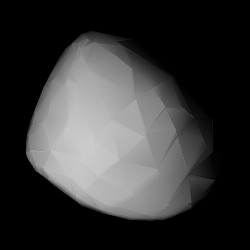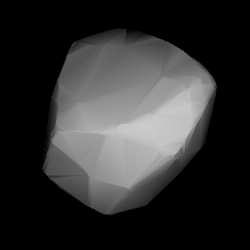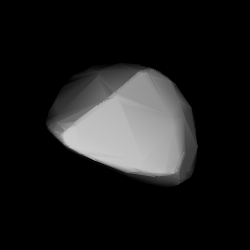Related Research Articles

1741 Giclas is a stony Koronis asteroid from the outer region of the asteroid belt, approximately 13 kilometers in diameter. It was discovered on 26 January 1960, by IU's Indiana Asteroid Program at Goethe Link Observatory near Brooklyn, Indiana, United States. It is named for astronomer Henry L. Giclas.
1762 Russell, provisional designation 1953 TZ, is a stony Koronian asteroid from the outer regions of the asteroid belt, approximately 16 kilometers in diameter. It was discovered by the Indiana Asteroid Program at Goethe Link Observatory near Brooklyn, Indiana, on 8 October 1953. The asteroid was named after American astronomer Henry Norris Russell.
2023 Asaph, provisional designation 1952 SA, is a dark asteroid from the outer regions of the asteroid belt, approximately 21 kilometers in diameter. It was discovered on 16 September 1952, by astronomers of the Indiana Asteroid Program at Goethe Link Observatory in Indiana, United States.
2026 Cottrell, provisional designation 1955 FF, is a dark asteroid from the inner regions of the asteroid belt, approximately 12 kilometers in diameter.
1462 Zamenhof, provisional designation 1938 CA, is a carbonaceous Themistian asteroid from the outer regions of the asteroid belt, approximately 27 kilometers in diameter. It was discovered on 6 February 1938, by Finnish astronomer Yrjö Väisälä at the Iso-Heikkilä Observatory in Finland. The asteroid was named after L. L. Zamenhof, the creator of Esperanto. It is a recognized Zamenhof-Esperanto object.
1157 Arabia, provisional designation 1929 QC, is an asteroid from the outer regions of the asteroid belt, approximately 29 kilometers in diameter. Astronomer Karl Reinmuth discovered it at the Heidelberg Observatory in southwest Germany on 31 August 1929. The asteroid was named for the Arabian Peninsula.

1457 Ankara, provisional designation 1937 PA, is a stony asteroid from the central region of the asteroid belt, approximately 18 kilometers in diameter. It was discovered on 3 August 1937, by German astronomer Karl Reinmuth at Heidelberg Observatory in southwest Germany, and later named for the Turkish capital city of Ankara.
1956 Artek, provisional designation 1969 TX1, is a dark Themistian asteroid from the outer regions of the asteroid belt, approximately 19 kilometers in diameter. It was discovered on 8 October 1969, by Soviet–Russian astronomer Lyudmila Chernykh at the Crimean Astrophysical Observatory in Nauchnyj. It was named after Artek, a Soviet Young Pioneer camp.
1354 Botha, provisional designation 1935 GK, is an exceptionally dark background asteroid from the outer regions of the asteroid belt, approximately 46 kilometers in diameter. It was discovered on 3 April 1935, by South-African astronomer Cyril Jackson at the Union Observatory in Johannesburg. The asteroid was named after South African prime minister Louis Botha.
1671 Chaika, provisional designation 1934 TD, is a background asteroid from the Astraea region in the central asteroid belt, approximately 10 kilometers in diameter. It was discovered on 3 October 1934, by Soviet astronomer Grigory Neujmin at the Simeiz Observatory on the Crimean peninsula. The assumed S-type asteroid has a rotation period of 3.8 hours. It was named for Soviet cosmonaut Valentina Tereshkova.
1541 Estonia, provisional designation 1939 CK, is an asteroid from the central regions of the asteroid belt, approximately 21 kilometers in diameter. It was discovered on 12 February 1939, by astronomer Yrjö Väisälä at the Iso-Heikkilä Observatory near Turku, Finland. The asteroid was named after the Baltic country of Estonia.
2016 Heinemann, provisional designation 1938 SE, is a carbonaceous Themistian asteroid from the outer regions of the asteroid belt, approximately 22 kilometers in diameter. It was discovered on 18 September 1938, by German astronomer Alfred Bohrmann at Heidelberg Observatory in southwest Germany, and later named after ARI-astronomer Karl Heinemann (1898–1970).
1524 Joensuu, provisional designation 1939 SB, is a carbonaceous asteroid from the outer region of the asteroid belt, approximately 42 kilometers in diameter. It was discovered on 18 September 1939, by Finnish astronomer Yrjö Väisälä at Turku Observatory in Southwest Finland, and named for the town of Joensuu.
17683 Kanagawa (provisional designation 1997 AR16) is a carbonaceous background asteroid from the outer region of the asteroid belt, approximately 22 kilometers (14 miles) in diameter. It was discovered on 10 January 1997, by Japanese astronomer Atsuo Asami at the Hadano Observatory, located 60 kilometers southwest of Tokyo, Japan. The asteroid was later named after the Japanese Kanagawa Prefecture.
1817 Katanga, provisional designation 1939 MB, is a stony Phocaea asteroid in from the inner regions of the asteroid belt, approximately 16 kilometers in diameter. It was discovered on 20 June 1939, by English-born South African astronomer Cyril Jackson at Johannesburg Observatory in South Africa. It is named for the Katanga Province.

1540 Kevola, provisional designation 1938 WK, is a dark background asteroid from the outer regions of the asteroid belt, approximately 42 kilometers in diameter. It was discovered on 16 November 1938, by astronomer Liisi Oterma at the Iso-Heikkilä Observatory in Turku, Finland. The asteroid was named after the Finnish Kevola Observatory.
1760 Sandra, provisional designation 1950 GB, is a carbonaceous asteroid from the outer regions of the asteroid belt, approximately 35 kilometers in diameter. It was discovered on 10 April 1950, by South African astronomer Ernest Johnson at Union Observatory in Johannesburg, and named after his granddaughter Sandra.

1940 Whipple is a carbonaceous background asteroid from the outer region of the asteroid belt, approximately 35 kilometers in diameter. It was discovered on 2 February 1975, by the Harvard College Observatory at its George R. Agassiz Station near Harvard, Massachusetts, in the United States, and named after astronomer Fred Whipple.
1461 Jean-Jacques, provisional designation 1937 YL, is a metallic asteroid from the outer region of the asteroid belt, approximately 34 kilometers in diameter. It was discovered on 30 December 1937, by French astronomer Marguerite Laugier at Nice Observatory in southern France, who named it after her son Jean-Jacques Laugier.
1478 Vihuri, provisional designation 1938 CF, is a stony asteroid from the inner regions of the asteroid belt, approximately 9 kilometers in diameter. It was discovered on 6 February 1938, by Finnish Yrjö Väisälä at Turku Observatory in Southwest Finland. The asteroid was named after a Finnish philanthropist by the name of A. Vihuri.
References
- 1 2 3 4 "JPL Small-Body Database Browser: 1728 Goethe Link (1964 TO)" (2017-05-05 last obs.). Jet Propulsion Laboratory. Archived from the original on 18 September 2020. Retrieved 7 June 2017.
- 1 2 3 Schmadel, Lutz D. (2007). "(1728) Goethe Link". Dictionary of Minor Planet Names – (1728) Goethe Link. Springer Berlin Heidelberg. p. 137. doi:10.1007/978-3-540-29925-7_1729. ISBN 978-3-540-00238-3.
- 1 2 3 4 5 6 7 "LCDB Data for (1728) Goethe Link". Asteroid Lightcurve Database (LCDB). Retrieved 21 December 2016.
- 1 2 3 4 Masiero, Joseph R.; Mainzer, A. K.; Grav, T.; Bauer, J. M.; Cutri, R. M.; Nugent, C.; et al. (November 2012). "Preliminary Analysis of WISE/NEOWISE 3-Band Cryogenic and Post-cryogenic Observations of Main Belt Asteroids". The Astrophysical Journal Letters. 759 (1): 5. arXiv: 1209.5794 . Bibcode:2012ApJ...759L...8M. doi:10.1088/2041-8205/759/1/L8 . Retrieved 21 December 2016.
- 1 2 3 4 Usui, Fumihiko; Kuroda, Daisuke; Müller, Thomas G.; Hasegawa, Sunao; Ishiguro, Masateru; Ootsubo, Takafumi; et al. (October 2011). "Asteroid Catalog Using Akari: AKARI/IRC Mid-Infrared Asteroid Survey". Publications of the Astronomical Society of Japan. 63 (5): 1117–1138. Bibcode:2011PASJ...63.1117U. doi: 10.1093/pasj/63.5.1117 . (online, AcuA catalog p. 153)
- 1 2 Behrend, Raoul. "Asteroids and comets rotation curves – (1728) Goethe Link". Geneva Observatory . Retrieved 21 December 2016.
- 1 2 3 Veres, Peter; Jedicke, Robert; Fitzsimmons, Alan; Denneau, Larry; Granvik, Mikael; Bolin, Bryce; et al. (November 2015). "Absolute magnitudes and slope parameters for 250,000 asteroids observed by Pan-STARRS PS1 - Preliminary results". Icarus. 261: 34–47. arXiv: 1506.00762 . Bibcode:2015Icar..261...34V. doi:10.1016/j.icarus.2015.08.007 . Retrieved 21 December 2016.
- 1 2 "1728 Goethe Link (1964 TO)". Minor Planet Center. Retrieved 21 December 2016.
- ↑ Schmadel, Lutz D. "Appendix – Publication Dates of the MPCs". Dictionary of Minor Planet Names – Addendum to Fifth Edition (2006–2008). Springer Berlin Heidelberg. p. 221. doi:10.1007/978-3-642-01965-4. ISBN 978-3-642-01964-7.